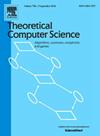Optimal gathering of robots in anonymous butterfly networks via leader election
IF 1
4区 计算机科学
Q3 COMPUTER SCIENCE, THEORY & METHODS
引用次数: 0
Abstract
Robots with very weak capabilities placed on the vertices of a graph are required to move toward a common vertex from where they do not move anymore. The task is known as the Gathering problem and it has been extensively studied in the last decade with respect to both general graphs and specific topologies. Most of the challenges faced are due to possible isometries observable from the placement of the robots with respect to the underlying topology. Rings, Grids, and Complete graphs are just a few examples of very regular topologies where the placement of the robots and suitable movements are crucial for succeeding in Gathering. Here we are interested in understanding what can be done in Butterfly graphs where really many isometries are present and most importantly unavoidable by any movement. We propose a Gathering algorithm for the so-called leader configurations, i.e., those where the initial placement of the robots admits the detection (and election) of one robot as the leader. We introduce a non-trivial technique to elect the leader which is of its own interest. We also prove that the proposed Gathering algorithm is asymptotically optimal in terms of synchronous rounds required.
基于leader选举的匿名蝴蝶网络中机器人的最优聚集
放置在图形顶点上的能力非常弱的机器人需要向它们不再移动的公共顶点移动。这个任务被称为“收集问题”,在过去的十年中,它在一般图和特定拓扑两方面得到了广泛的研究。所面临的大多数挑战是由于机器人相对于底层拓扑的位置可能观察到的等距。环、网格和完全图只是规则拓扑的几个例子,在这些拓扑中,机器人的位置和合适的移动对于在《Gathering》中取得成功至关重要。在这里,我们感兴趣的是了解蝴蝶图中可以做些什么,因为蝴蝶图中存在许多等距图,最重要的是,任何运动都不可避免地存在等距图。对于所谓的leader配置,即机器人的初始位置允许检测(和选择)一个机器人作为leader的配置,我们提出了一种Gathering算法。我们引入了一种不平凡的技术来选举符合自身利益的领导人。我们还证明了所提出的聚类算法在同步轮数方面是渐近最优的。
本文章由计算机程序翻译,如有差异,请以英文原文为准。
求助全文
约1分钟内获得全文
求助全文
来源期刊

Theoretical Computer Science
工程技术-计算机:理论方法
CiteScore
2.60
自引率
18.20%
发文量
471
审稿时长
12.6 months
期刊介绍:
Theoretical Computer Science is mathematical and abstract in spirit, but it derives its motivation from practical and everyday computation. Its aim is to understand the nature of computation and, as a consequence of this understanding, provide more efficient methodologies. All papers introducing or studying mathematical, logic and formal concepts and methods are welcome, provided that their motivation is clearly drawn from the field of computing.
 求助内容:
求助内容: 应助结果提醒方式:
应助结果提醒方式:


